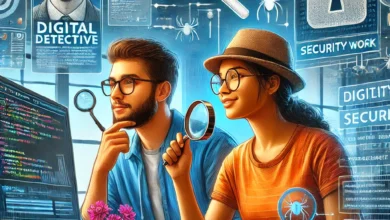Bug Bounty Hunter’s Code of Ethics: A Guide to Responsible Bug Hunting
From the Back Alleys of Zero-Day Exploits to the Frontlines of Ethical Reconnaissance

In the vast and ever-expanding digital universe, bug bounty hunting emerges as a pivotal frontier reminiscent of the adventurous Wild West that history romanticizes. This contemporary domain is not just about technological dexterity; it’s a harmonious blend of intellectual challenge, the allure of potential rewards, and the overarching mantle of ethical responsibility. As we navigate an era where cyber-attacks and data breaches are no longer isolated events but recurrent headlines, the role of bug bounty hunters becomes increasingly central. These individuals, often working behind the scenes, are the guardians of our digital sanctuaries. They venture into the intricate labyrinths of codes and systems, not for malicious intent but to identify and rectify vulnerabilities, ensuring a safer online experience for all. Their dedication is not solely driven by monetary incentives but is underpinned by a commitment to safeguarding the integrity of the digital realm against malicious threats. As the dynamics of cybersecurity evolve, it is these unsung heroes who stand as our first line of defense, making their understanding, recognition, and support ever more critical.
A Retrospective Journey: Tracing the Roots of Bounty Initiatives
The world of bug bounty programs didn’t spontaneously spring into existence. Rather, it was a gradual and deliberate evolution spurred by the necessity of the burgeoning digital age. At the heart of this story is the ever-present tug-of-war between innovation and vulnerability. As companies ventured into the uncharted waters of the digital domain, they soon realized that with the boon of connectivity came the bane of potential cyber-attacks.
Netscape’s groundbreaking move in the 1990s to incentivize the discovery of vulnerabilities in its Navigator 2.0 browser could be described as the proverbial “first stone” that rippled across the pond of cybersecurity. This wasn’t just a commercial decision; it was a bold acknowledgment of the vast reservoir of external cybersecurity talent that existed outside corporate walls. It signified a shift in perspective, recognizing that safeguarding digital assets was not a solitary endeavor but a collaborative one.
With this pivotal move, Netscape didn’t merely set a precedent; it demonstrated foresight. It anticipated an era where the intricacies of cybersecurity would be too multifaceted for any single organization to tackle alone. By turning to the external world, they leveraged a distributed network of vigilant eyes and keen minds, all devoted to a singular purpose: bolstering the integrity of digital platforms.
Platforms such as HackerOne and Bugcrowd, which have since emerged as stalwarts in the industry, owe their genesis to such foundational shifts in thinking. These platforms epitomize the industry’s progress, acting not just as bridges but as facilitators. They streamline the communication between vast conglomerates and independent security enthusiasts, ensuring that potential threats are identified, communicated, and mitigated with efficiency and precision.
Reflecting on these origins, it becomes evident that the bug bounty ecosystem is not just a reactive measure against cyber threats. It’s a proactive initiative, continually evolving, adapting, and preparing for challenges yet to manifest. As we look to the future, understanding this historical context is crucial. It reminds us that collaboration, adaptability, and mutual respect between companies and the bug-hunting community have been, and will remain, the pillars supporting the ever-growing edifice of cybersecurity.
Legendary Narratives: Chronicles of Ethical Disclosures
The tale of Alex Rice is etched in the annals of responsible disclosure. Discovering a significant vulnerability in Facebook, Rice opted for the high road. His decision to report rather than exploit led to both monetary reward and acclaim, emphasizing the weight of moral choices in the domain.
Bug Bounty Hunting’s Ethical Mandate: The Ten Imperatives
- Grasping the Digital Terrain Every online environment possesses its distinctiveness. To tread effectively, one must comprehend the idiosyncrasies, from intricate APIs to vast web servers.
- The Primacy of Permission The cyber universe isn’t a limitless expanse. Boundaries exist, and recognizing them transcends ethics—it pertains to legal obligations.
- The Sanctity of Information Living in the information age, the responsibility of safeguarding accessed data eclipses the triumph of uncovering vulnerabilities.
- Mastering the Disclosure Craft A report that resonates is more than a list—it’s an articulate narrative that offers context, suggests remediation, and validates reproducibility.
- Gentle Footprints in the Digital Sand Bounty hunters, akin to historians in ancient ruins, should operate with a subtlety that leaves systems intact and operational.
- Leveraging Collective Intellect Embracing the collective wisdom of fellow hunters can be transformative. Forums, chats, and collaboration platforms are treasure troves of fresh outlooks and methodologies.
- Relentless Curiosity: The Innovator’s Ethos Echoing Steve Jobs, the ever-changing digital realm demands an insatiable hunger for learning and innovation.
- The Wisdom of Retreat Astute judgment in discerning when to backtrack is as critical as the pursuit itself.
- Championing Ethical Excellence Veteran hunters bear the onus of guiding newcomers, ensuring the continuity of ethical standards and professional decorum.
- Ovation and Acknowledgment Celebrate every small victory. In the cybersecurity realm, a vulnerability patched timely is a catastrophe circumvented.
The Personal Ethical Compass: Moralities Beyond Guidelines
Beyond codified ethics, each hunter cultivates a personal moral compass refined over countless challenges. This internal guidepost offers direction when situations blur the line between right and wrong.
The Trust Waltz: Corporate Trust in External Experts
The corporate dilemma—needing external cybersecurity expertise while being wary of external access—has seen alleviation with structured bug bounty platforms. These platforms usher in a systematic, transparent conduit for reporting potential threats.
Diving Deeper: Advanced Techniques in Bug Hunting
The realm of bug hunting has transformed profoundly over the years, paralleling the complexity and evolution of technology itself. As digital platforms have grown in intricacy, so too have the techniques used by security researchers to probe, analyze, and fortify these systems. Gone are the days when basic penetration testing sufficed; today’s bug hunters require an expansive toolkit, deep technical insight, and a relentless drive for innovation.
Fuzzing, for instance, has come a long way from its rudimentary origins. This technique, which involves inundating software with a barrage of random data to provoke potential crashes or malfunctions, has grown in sophistication. Modern fuzzers, equipped with artificial intelligence, can adapt their “attack” patterns, learning from previous iterations to identify vulnerabilities with higher accuracy and efficiency.
The realm of concurrency issues, especially race conditions, offers another glimpse into the depth of advanced bug hunting. Race conditions arise when system behavior becomes unpredictable due to the timing or ordering of specific events. Exploiting such vulnerabilities requires a nuanced understanding of system processes, synchronization, and the intricacies of multitasking environments. With the proliferation of multi-core processors and distributed systems, understanding and mitigating race conditions have become paramount.
Then there’s the challenge of Content Security Policy (CSP) bypasses and Server Side Request Forgery (SSRF) vulnerabilities. A CSP bypass might allow a hacker to execute malicious scripts on a web page, circumventing the very measures meant to prevent such intrusions. SSRF vulnerabilities, on the other hand, can enable attackers to induce the server into making requests on their behalf, potentially granting them access to restricted data or functionalities.
Another advanced arena is that of post-quantum cryptography. As the world stands on the precipice of a quantum computing revolution, traditional cryptographic techniques face potential obsolescence. Forward-thinking bug hunters are already delving into the vulnerabilities of quantum-resistant algorithms, ensuring that as technology evolves, security measures keep pace.
Additionally, with the rise of the Internet of Things (IoT) and edge computing, bug hunting has expanded beyond conventional IT infrastructure. Security researchers are now probing smart devices, wearable technology, and distributed networks, searching for vulnerabilities in a world where even a refrigerator or a light bulb could be a potential cyber threat vector.
In this intricate dance of defense and exploration, the role of the bug hunter is not merely to discover vulnerabilities but to understand their root causes, implications, and potential ripple effects. They must anticipate the methods and motivations of potential adversaries, staying always a step ahead in this ever-evolving game of digital cat and mouse.
As the layers of technology deepen and proliferate, the techniques and knowledge required for effective bug hunting expand in tandem. The marriage of technical expertise with creativity, foresight, and ethical responsibility ensures that the world of bug hunting remains an exciting, dynamic, and crucial facet of the broader cybersecurity landscape.
Understanding Dynamics: The Hunter-Company Interplay
While the essence of bug bounty is collaboration, it isn’t devoid of disputes—be it over bounty amounts, vague scopes, or overlooked reports. Ethics play a pivotal role in conflict resolution. Platforms like HackerOne serve as mediators, emphasizing the significance of transparent communication and timely resolutions.
Community as Catalyst: Advancing Skills Collectively
The cybersecurity community is a powerhouse of shared learning. Events like DEF CON function as epicenters of knowledge dissemination, hosting workshops, discussions, and competitions, offering bounty hunters avenues to refine their craft. Corporates, recognizing the expertise showcased, often tap into these events to identify and onboard talent.
Apple’s Embrace: A Testament to Evolving Relations
Apple’s historical hesitancy towards external security audits saw a revolution with its iOS Security Research Device program. By providing specialized iPhones to select researchers, Apple showcased a maturing relationship with the bug bounty community, emphasizing the symbiotic potential of trust and proactive vulnerability identification.
Conclusion
As we navigate the intricate labyrinths of the digital age, the role of bug bounty hunting rises not just as a technical necessity but as a beacon of ethical responsibility within the broader tapestry of cybersecurity. This practice, which once operated in the fringes, has now moved center stage, mirroring our growing reliance on digital platforms and the intertwined nature of technology in our everyday lives.
The ongoing dance between technological advancements and security imperatives necessitates the growth and evolution of bug hunting. In a world where every touchpoint, from smart homes to financial infrastructures, is becoming interconnected, the stakes are higher than ever. Ensuring that these systems are robust is not merely a matter of preventing financial loss or technical malfunction; it’s about safeguarding the very fabric of our society, the trust we place in digital systems, and the data that represents our digital identities.
This heightened emphasis on bug bounty hunting also underscores a paradigm shift in how organizations perceive cybersecurity. No longer is it seen merely as a technical challenge to be handled by internal teams. Instead, it’s acknowledged as a collaborative effort, where external expertise, epitomized by the global community of bug hunters, plays a pivotal role. Their fresh perspectives, diverse methodologies, and relentless curiosity are assets that complement traditional security measures.
Moreover, the symbiotic relationship between companies and bug hunters speaks volumes about the changing nature of professional trust. Organizations now openly invite external scrutiny, recognizing that transparency, accountability, and community engagement are integral to fostering genuine security. This cultural shift, underpinned by ethical foundations, is a testament to the transformative power of collaboration in the face of adversity.
In retrospect, the journey of bug bounty hunting offers hope and a roadmap for future challenges. As technology continues to evolve, bringing forth new marvels and complexities, the spirit of ethical exploration championed by bug hunters ensures that our digital frontiers remain secure, resilient, and inclusive. Embracing this ethos, we move forward with confidence, equipped with the tools, community, and moral compass to navigate the uncertainties and promises of tomorrow.




